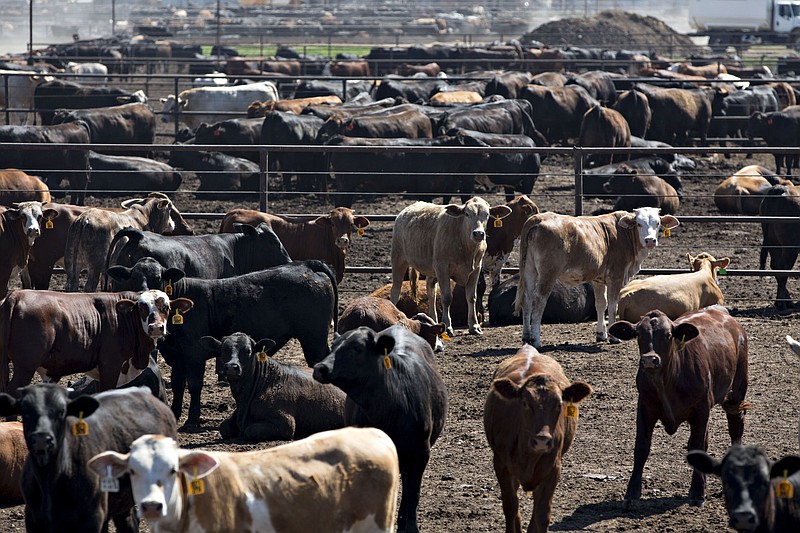It's not just consumers getting riled up about rising beef prices. Cattle producers are, too.
Ranchers and cattle feeders are seething over a pattern they now consider all too familiar: the cost of hamburgers and steaks soar at the grocery store, yet the prices producers get for the animals barely budges. The market's dominated by four giant meatpacking companies that together control more than 80% of U.S. beef processing.
"It's a red-line level of frustration," said Colin Woodall, chief executive officer of the National Cattlemen's Beef Association, the largest trade association for cattle producers.
That ire is driving political momentum for more oversight of cattle markets just as antitrust and competition issues gain new traction in Washington, where a backlash against big technology firms is fueling broader concerns about corporate behemoths abusing dominant positions.
The Biden administration views the pricing patterns in beef processing as evidence that concentration is having damaging effects on the supply chain and rural America, a senior U.S. Department of Agriculture official said on condition of anonymity. USDA officials are looking at ways to use their regulatory authority to reduce the imbalance in market power, the official said.
Six farm and cattle trade groups this week united behind demands for meatpackers to disclose more information on cattle purchases, and for the Justice Department to publicly report on an antitrust investigation it launched last May into the four major beef processors. Sixteen members of Congress wrote the Justice Department the same day pressing for a progress report on the probe.
Lawmakers have introduced two legislative packages to require more transparency in pricing and terms of cattle purchases, in the hopes that it will give producers more leverage in transactions. Republican Sen. Deb Fischer of Nebraska, who sponsored one, said she is "very optimistic" some version of an enhanced disclosure bill will pass in Congress this year.
Rural lawmakers are sensitive to cattle producers' pain. Beef cattle operations account for more than a third of U.S. farms and ranches, making it the single largest segment in the nation's agriculture. Ranchers are also hurting from an expanding drought. Feedlot operators, which typically fatten cattle before they go to packers for slaughter, face soaring corn prices.
"At home, I hear about it all the time," said Fischer, who described encounters with cattle feedlot operators losing hundreds of dollars per animal. "You can't stay in business with those kind of losses."
Meanwhile, packers are prospering. Tyson Foods Inc., the largest U.S. meat company, earlier this month reported record margins of 11% for beef in its second quarter. The company's stock is up 22% so far this year, compared with 9% for the benchmark S&P 500 index.
The beef profit margins will eventually decline but remain above historical levels, Tyson's Chief Executive Officer Dean Banks said at a conference Wednesday.
With pandemic restrictions easing, restaurants are reopening and buying meat. Flush with stimulus payments and improving incomes from a recovering economy, Americans have been willing to pay up for more expensive steaks and burgers.
Since March 12, the wholesale price of beef has shot up 43%, according to the USDA. Cattle prices have risen only 5%.
Producers see a rerun of their plight during covid-19 disruptions last year, when virus outbreaks slowed slaughterhouses, and the previous year, when a fire temporarily shut down a meat plant in Holcomb, Kan., Woodall said. Each time, beef prices soared while cattle prices dropped.
CAN'T AFFORD IT
Renee Strickland, a fourth-generation cattle rancher based in Myakka City, Fla., said she sometimes has to pass up beef for chicken at the grocery store because it's too expensive for her.
"I'm just so angry that I can't afford the product that I produce," she said.
The spread between the price packers pay for cattle and the price they receive for wholesale beef keeps hitting new records, first after the August 2019 fire, and then after the pandemic hit. A USDA report that examined beefpacker margins reached no conclusion on whether prices were manipulated.
Greg Ibach, the undersecretary of agriculture in the Trump administration who oversaw livestock market regulation, said markets never really returned to normal levels after the Holcomb fire. In the year before the Aug. 9, 2019, fire, packers' operating margins on cattle averaged $137 a head. Since then, it has averaged $331 a head, according to data maintained by HedgersEdge.com.
"It never really has corrected itself," Ibach said. "I don't think the profits are being shared across the value chain in the same proportions that historically has happened."
Meatpacking companies say they're constrained and struggling to attract workers, particularly after the covid-19 outbreaks that made the industry an early epicenter of the pandemic. Tyson executives said this month that they've raised wages but still face high employee turnover and absenteeism.
"Despite the pandemic's challenges the market is competitive and growing," Sarah Little, a spokeswoman for the North American Meat Institute, a trade group, said in a statement.
